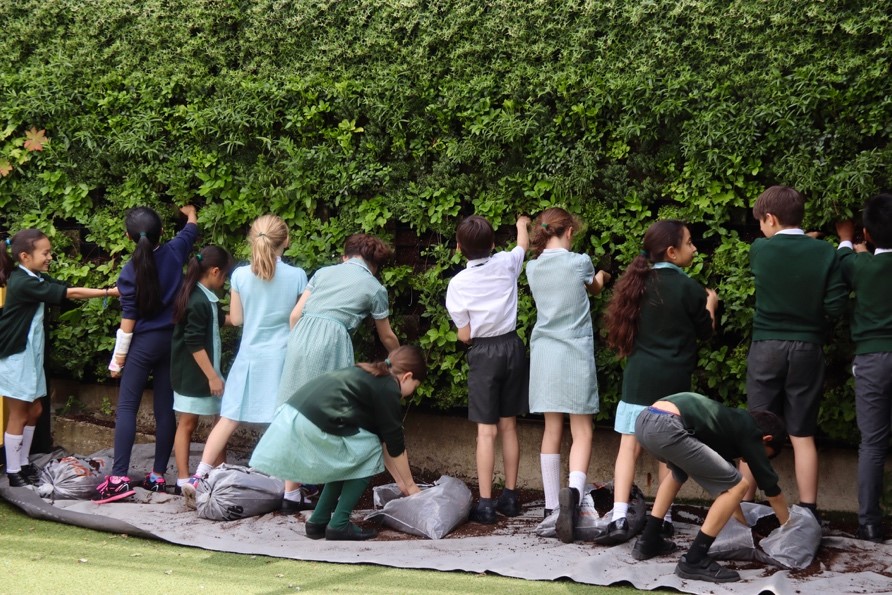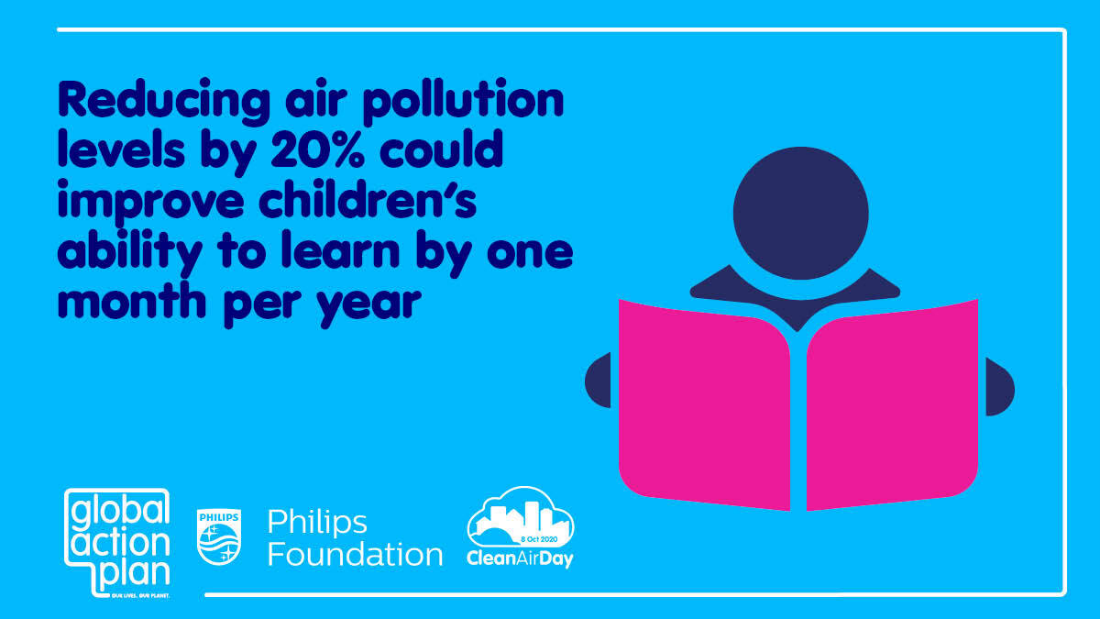Just metres away from a six-lane main road with 100,000 vehicles per day, St Mary’s School in Chiswick was one of the most polluted schools in London a few years ago. With pollution levels many times over the legal limit, the Headteacher sometimes had to resort to restricting outdoor play time when pollution levels were very high.
Concerned about what impact this could be having on the children’s health and wellbeing, a group of parents, led by Andrea Carnevale, set up a project to tackle this issue and create a cleaner and safer school environment for the children.
A huge fundraising campaign was launched by the parents and school to secure funding from the community and local businesses. With a budget of over £75k, and offers of ‘pro bono’ technical support from specialist consultancies, the school was able to create a whole-school approach to improving air quality, which included installing a huge green wall along the boundary with the A4, as well as putting filters in classrooms to tackle indoor pollution, and other technological and behaviour change initiatives.
The living wall that was installed is 134m long, consisting of 20,000 plants belonging to 25 different plant species. There is an ornamental wall (35m), climbers and trellis (70m), and an educational wall (29m). Each segment was designed in response to the adjacent area, its use and the value provided.
The green wall (and Airlite paint which was put onto some surfaces of buildings) has shown reductions of up to 28% of NO2 concentrations across the school.

Additional benefits include:
🌳 Improved environment
🌳 More time spent outdoors
🌳 Greater diversity of activities and
🌳 New learning from nature
Now, as new research has been published showing just how much of an impact air pollution has on children, campaigners are urging schools across the country to also take action both inside and outside the classroom.
The University of Manchester (UoM), Global Action Plan, and the Philips Foundation have published new modelling demonstrating that maintaining lower indoor and outdoor air pollution (PM25 & NO2) levels could improve a child’s ability to learn. The model finds that maintaining lower air pollution levels in and around school grounds by 20% could enhance the development of a child’s working memory by 6%, the equivalent of four weeks extra learning time per year.
Air quality data by Department for Environment, Food and Rural Affairs (DEFRA) shows air pollution decreased by up to 40% on average across the UK in peak national lockdown during April and May 2020 compared to the same time last year.
Based on the modelling by UoM, a 20% increase in air pollution could stunt the development of a child’s working memory by up to four weeks per year.
Up to 2,000 schools and nurseries are close to roads with air pollution above the baseline level of NO2 used in the model, meaning that at least 500,000 children are exposed to levels of pollution that would affect working memory. But the impact is also felt at lower levels than the 40µg/m3 baseline and so many more thousands of pupils also stand to benefit from a reduction in pollution.
In terms of PM25, the most recent national investigation found that 8,549 schools, colleges and nurseries are in places with pollution levels that are above WHO health limits, equating to at least 1.7 million children in these locations. However, the exact number of pupils held back by excessive pollution is unknown because there is no national monitoring system for air quality in schools.
In light of this, campaigners including support from the All-Party Parliamentary Group on Air Pollution (APPG), National Education Union (NEU) and National Association for Head Teachers (NAHT), are calling on the government and local councils to guide schools in using the newly launched Clean Air for Schools Framework.
The Clean Air for Schools Framework, developed by Global Action Plan, the Philips Foundation and the UoM, is a free online tool that gives teachers, headteachers, parents and local authorities a bespoke blueprint of actions for tackling air pollution in and around the school.
Its database of actions includes interventions that can be taken both inside and outside school grounds including implementing school streets, improving indoor ventilation and consolidating deliveries. At a time when schools are urgently reviewing their operations, implementing major changes to the movement of pupils and parents on their premises, the group is calling on all schools across the UK & Ireland to adopt and implement the framework, with support from local and national government.
All actions in the Clean Air for Schools Framework have been vetted by existing research, academic insights and in-school air quality testing by the University of Manchester and further refined in collaboration with teachers and students. Notably, in classroom research conducted at Russell Scott Primary School in Greater Manchester found that using an air purifier over a short period of time can reduce levels of indoor air pollution (PM25) by up to 30% in classrooms.
The findings are part of the Clean Air for Schools Programme, a year-long research project which looked at how air pollution and its effects on children can be tackled in schools across the UK & Ireland. Launched in October 2019, the Programme includes additional field research undertaken in 19 schools totalling approximately 6,000 students across Greater Manchester, looking into the most effective actions for reducing indoor and outdoor air pollution. In addition to improving children’s health, the Programme’s latest findings from the UoM modelling show that reducing air pollution will also improve children’s ability to learn, supporting teachers who are already under pressure to ensure pupils regain lost education time during lockdown.

“This year long research project has uncovered the effects air pollution has on our children’s ability to learn, as well as their health,” says Chris Large, Co-CEO at Global Action Plan. “Given lockdown restrictions have already impeded learning time, we must give all children a fighting chance, especially those in pollution hotspots who are also likely to be victims of the attainment gap. The new Clean Air for Schools Framework is now available for free to help any school set up a clean air action plan, but schools cannot do this alone. We ask the government to bring together all parties with potential solutions – NGOs, local government, education leaders and businesses – to combine under one national effort to eliminate harmful pollutants from schools.”



